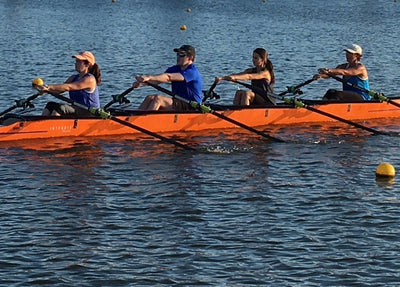
Learn to Row
Whether it’s early morning, mid-afternoon, or early-evening many people are taking to the water to try a new total body sport. Rowing, which was established as an Olympic sport in the year 1900, has recently gained popularity among the active adult community. As a sport which promotes cardiovascular and muscular health, rowing can also provide mental focus, clarity and anxiety reduction.
But what exactly is rowing? Is it what you see in the movies that feature Central Park, in New York City? Couples taking leisurely paddles around a stagnant pond in wide wooden boats surrounded by swans and ambiance? The short answer is no. While this is considered rowing, it is not considered the sport of rowing.
The sport of rowing consists of two types, Sweep Rowing and Sculling. Sweep Rowing usually consists of at least two people (but can include up to eight people), each person holding one oar, and typically involves a coxswain, a person who is in charge of motivation and steering. Sculling, in which the rower holds two oars on either side of the boat, can be done by someone who would like to row by themselves or with partners.
Many boathouses across the United States offer Learn to Row programs for adults wanting to break into the sport. As you learn and advance your skills, there are numerous opportunities available for competition and adventure.
Rowing is a sport with a longstanding tradition of community. Because it is still a relatively small-scale sport, many of the competitors form bonds and keep in touch from across the country, when they aren’t competing near one another. In addition to friendships formed at competitions, there is also a very strong bond formed between the local adult teams.
There are a few different levels of rowing. There is Junior Level rowing, specifically meant for teenagers between the age of 13-18. These rowers compete for private clubs, much like a club soccer team, and sometimes scholastically. This is followed by Collegiate Rowing, which is one of the fastest growing college sports in the United States. Athletes can be awarded scholarships to help cover the expenses of tuition and room and board. Then there is Elite Level rowing, which is the Olympic and Professional level, the athletes who represent America at international competitions. And finally, the masters level of rowing, where anyone aged twenty-five and beyond can compete against one another for medals and glory.
When rowers compete, they go to large scale events called regattas. You may have heard the term regatta used before to describe a sailboat competition. Rowing Regattas are set up to resemble a tournament, where boats race head to head for the fastest time recorded.
In addition to rowing outside in the elements, rowers also train indoors on a machine called an ergometer. Most gyms have at least one rowing machine located with their cardio equipment. Rowing on an ergometer provides the body with a total workout, targeting the cardiovascular system in addition to the legs, abdominals, back and arm muscles.
While rowing is relatively low impact on the water, doing this total body workout can cause soreness and stress on the areas of the body that aren’t used to the movements. As with any sport, rowers can occasionally experience some issues with the repetitive movements and it is recommended that a pain relief cream is used on sore muscle areas.
For a new adventure, and for a chance to build a healthier body and long-lasting friendships you might consider trying rowing, to make a splash in your daily routine.


 {{/image.src}}
{{/image.src}}





